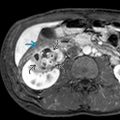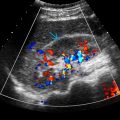KEY FACTS
Terminology
- •
Succenturiate lobe (SL): 1 or more accessory placental lobes connected by submembranous fetal vessels
Imaging
- •
2 or more separate placentas
- ○
Color Doppler shows connecting vessels
- ○
- •
Find placental cord insertion
- ○
Might be on small placenta
- ○
Might be velamentous or marginal
- ○
- •
Risk for vasa previa if placental tissue in lower uterus
- ○
Crossing fetal vessels within 2 cm of internal cervical os
- ○
Top Differential Diagnoses
- •
Acute placental abruption
- ○
Isoechoic blood mimics smaller placenta
- ○
- •
Focal myometrial contraction
- ○
Contracted focus of muscle is echogenic
- ○
Clinical Issues
- •
Seen in 5-6% of all pregnancies
- ○
More common with twins and with in vitro fertilization
- ○
- •
↑ risk for retained placenta after delivery
- •
SL with velamentous cord insertion has more complications
- ○
↑ risk of growth restriction, ↑ risk for cord trauma
- ○
Scanning Tips
- •
Scan entire uterus before assigning placental location
- ○
Look for additional placental lobes
- ○
If 1 additional lobe seen, look for more
- ○
Look for vascular connections between lobes
- –
Color Doppler to show connections
- –
- ○
- •
Perform TVUS for any case in which any placental tissue or connecting vessels are suspected in lower uterus
- ○
Rule out vasa previa, low-lying placenta, and placenta previa of SL
- ○
Move fetal head to see internal os well
- ○
 and posterior
and posterior  placentas are connected by submembranous communicating vessels
placentas are connected by submembranous communicating vessels  carrying fetal blood. The main placental lobe in this case is posterior, and the anterior lobe is considered accessory (succenturiate).
carrying fetal blood. The main placental lobe in this case is posterior, and the anterior lobe is considered accessory (succenturiate).
Stay updated, free articles. Join our Telegram channel

Full access? Get Clinical Tree








